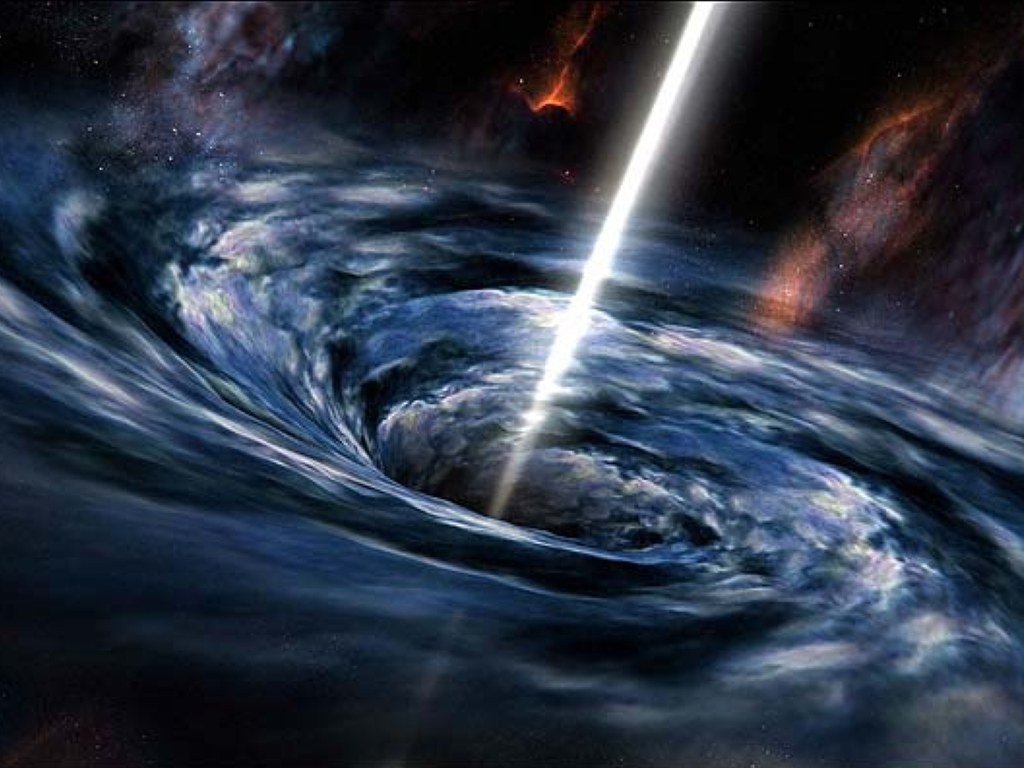Approaching the Event Horizon
What happens to an
object as it approaches the event horizon of a black hole?
Even light cannot escape from the event horizon of a black
hole, so we can conclude that gravity is pulling in
objects at or faster than the speed of light. So an object
falling into a black hole would move at a faster and
faster speed approaching the speed of light. Remember that
as an object approaches the speed of light, the fabric of
space-time becomes distorted in a way that the properties
of space-time is changed for that object. This is because
its effective mass becomes infinite as the object
approaches infinite speed. In the previous section, we
talked about how time dilation and length contraction
affects observers in different inertial frames, but how do
these phenomena of special relativity apply to objects
affected by the powerful gravitation force near a black
hole?
Imagine we are
observing an object falling into a black hole. As the
object falls into the black hole, tidal forces will rip
the object apart so that it stretches out like a piece of
spaghetti in a process aptly named spaghettification. This
is a purely physical process and not the kind of change we
are interested in. We want to know the relativistic
changes that are happening to the object. Let's take a
closer look at how special relativity affects objects very
close to the event horizon of a black hole.
Perspective of an Outside Observer
An object approaching the event horizon
would appear to be slowing down as it approaches the black
hole instead of speeding up as we would expect. This is
because of time dilation, which slows the passing of time
for an object moving close to the speed of light with
respect to an outside observer. The object eventually
would slow down until it stops moving when it reaches the
event horizon because that is when it will be moving at
the speed of light. An outside observer will never see the
object passing the event horizon, firstly because light
cannot escape, but even if it could, the time dilation of
the object would become infinite meaning it would take an
infinite amount of time for it to cross the event horizon.
Second, the object
would appear to be contracting or becoming flattened in
the direction of its motion. This flattening only occurs
in one direction so that when the object reaches the event
horizon, it essentially becomes a two dimensional object
from the perspective of an outside observer.
Perspective of an Observer Falling
into a Black Hole
It becomes even more interesting when
we take the perspective of the object falling into a black
hole. As you fall into a black hole, you would not notice
any of the time dilation or length contraction that an
outside observer would see in you. For you, time would
pass at the same rate as it always has been, so that you
would fall towards the black hole, pass the event horizon,
and hit the singularity in almost no time at all. But when
you observe the rest of the universe outside the black
hole, time would speed up faster and faster as you
approach the event horizon. Then the universe would go
infinitely into the future when you reach the event
horizon.
You would also not
experience any length contraction on yourself. You would
still have the same 3 dimensional shape you always did
(except for any spaghettified parts). But as you get
closer to the event horizon, everything in the universe
will become contracted until it becomes a tiny point above
you. Essentially, the infinite universe turns into a
singularity when you hit the event horizon.
Event Horizon as the Boundary of the
Universe
Think about what we have talked about
so far. When you approach the event horizon of a black
hole, you are actually approaching the limit of
space-time. What this means is that when you reach the
event horizon of a black hole, you are also reaching the
end of space-time. We have this notion of a boundary as
something that is outside and beyond, but the universe is
something that is infinite in both space and time! In
order to find the boundary of something that is infinite,
you must approach the infinite itself.


